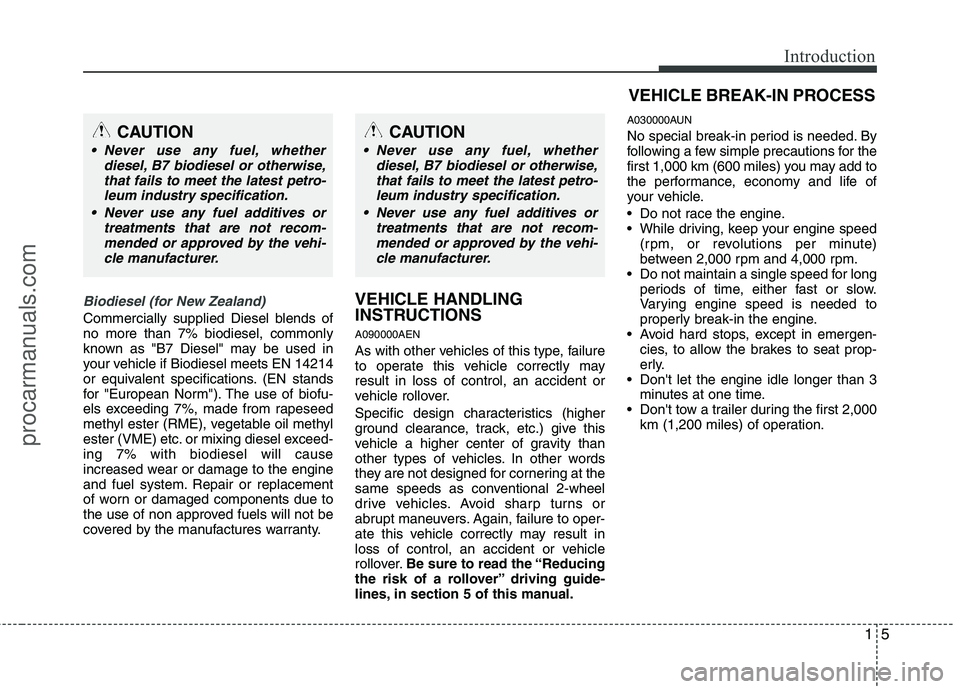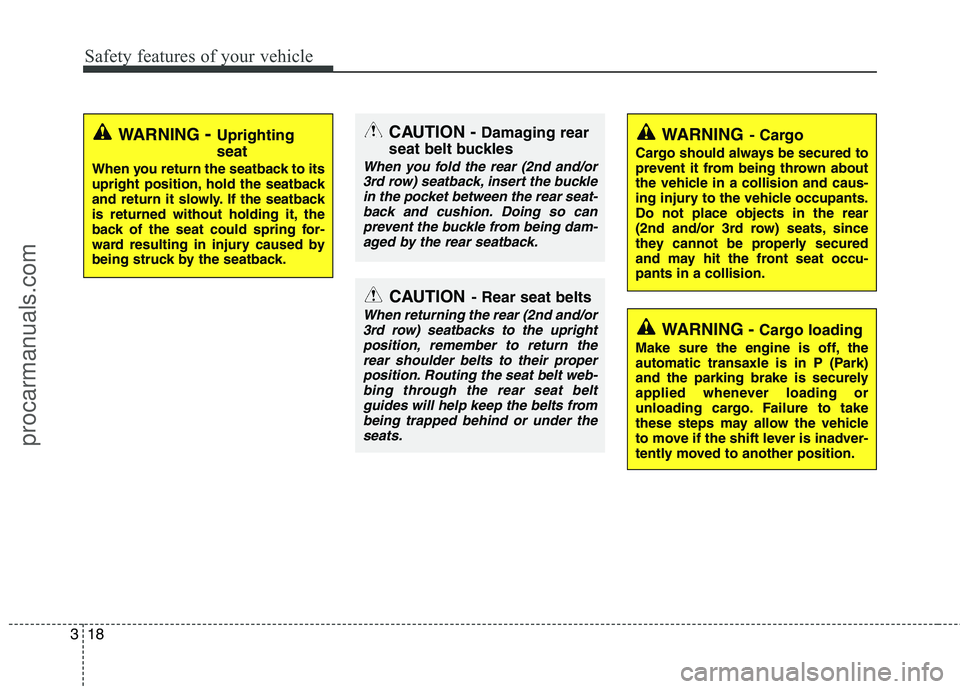2011 HYUNDAI VERACRUZ brake
[x] Cancel search: brakePage 12 of 419

15
Introduction
Biodiesel (for New Zealand)
Commercially supplied Diesel blends of no more than 7% biodiesel, commonly
known as "B7 Diesel" may be used in
your vehicle if Biodiesel meets EN 14214
or equivalent specifications. (EN stands
for "European Norm"). The use of biofu-
els exceeding 7%, made from rapeseed
methyl ester (RME), vegetable oil methyl
ester (VME) etc. or mixing diesel exceed-ing 7% with biodiesel will cause
increased wear or damage to the engine
and fuel system. Repair or replacement
of worn or damaged components due to
the use of non approved fuels will not be
covered by the manufactures warranty.VEHICLE HANDLING
INSTRUCTIONS A090000AEN
As with other vehicles of this type, failure
to operate this vehicle correctly mayresult in loss of control, an accident or
vehicle rollover.
Specific design characteristics (higher
ground clearance, track, etc.) give this
vehicle a higher center of gravity than
other types of vehicles. In other words
they are not designed for cornering at the
same speeds as conventional 2-wheel
drive vehicles. Avoid sharp turns or
abrupt maneuvers. Again, failure to oper-
ate this vehicle correctly may result in
loss of control, an accident or vehicle
rollover.
Be sure to read the “Reducing
the risk of a rollover” driving guide-
lines, in section 5 of this manual. A030000AUN
No special break-in period is needed. By
following a few simple precautions for the
first 1,000 km (600 miles) you may add to
the performance, economy and life of
your vehicle.
Do not race the engine.
While driving, keep your engine speed
(rpm, or revolutions per minute)
between 2,000 rpm and 4,000 rpm.
Do not maintain a single speed for long
periods of time, either fast or slow.
Varying engine speed is needed to
properly break-in the engine.
Avoid hard stops, except in emergen- cies, to allow the brakes to seat prop-
erly.
Don't let the engine idle longer than 3 minutes at one time.
Don't tow a trailer during the first 2,000
km (1,200 miles) of operation.
VEHICLE BREAK-IN PROCESS
CAUTION
Never use any fuel, whether
diesel, B7 biodiesel or otherwise,
that fails to meet the latest petro-leum industry specification.
Never use any fuel additives or treatments that are not recom-
mended or approved by the vehi- cle manufacturer.
CAUTION
Never use any fuel, whether diesel, B7 biodiesel or otherwise,
that fails to meet the latest petro-leum industry specification.
Never use any fuel additives or treatments that are not recom-
mended or approved by the vehi- cle manufacturer.
procarmanuals.com
Page 13 of 419

Introduction
6
1
INDICATOR SYMBOLS ON THE INSTRUMENT CLUSTER
Seat belt warning light
High beam indicator
Turn signal indicator
ABS warning light (if equipped)
Parking brake & Brake fluid
warning light
Engine oil pressure warning light
4WD system warning light (if equipped)
4WD LOCK indicator (if equipped)
ESP indicator (if equipped)
ESP OFF indicator (if equipped)
Malfunction indicator (if equipped)
Air bag warning light (if equipped)
Cruise indicator (if equipped)
Cruise SET indicator (if equipped)
Immobilizer indicator (if equipped)
Low fuel level warning light
Glow indicator (Diesel only)
Fuel filter warning light (Diesel only)
* For more detailed explanations, refer to “Instrument cluster” in section 4.
Charging system warning light
Low windshield washer fluid
level warning light (if equipped)
A050000BEN-EE
Door (and tailgate) open position indicator (if equipped)
Overspeed warning light (if equipped)
120km/h
Key out indicator (if equipped) KEY
OUT
AIR
BAG
Door ajar warning light (if equipped)
Tailgate open warning light (if equipped)
TPMS (Tire Pressure Monitoring System) malfunction indicator (if equipped)
Low tire pressure telltale (if equipped)
Low tire pressure position tell- tale (if equipped)
procarmanuals.com
Page 15 of 419

Your vehicle at a glance
2
2
INTERIOR OVERVIEW
1. Door lock/unlock button ....................4-14
2. Driver position memory system
button*...............................................4-37
3. Outside rearview mirror folding button*...............................................4-48
4. Outside rearview mirror control switch ................................................4-47
5. Central door lock switch....................4-14
6. Power window lock button ................4-27
7. Power window switches ....................4-24
8. Air vent ..............................................4-90
9. Front fog light switch*........................4-76
10. Head lamp leveling device*.............4-77
11. Rear fog light switch* .....................4-77
12. Instrument panel illumination control knob ................................................4-50
13. 4WD LOCK button*.........................5-16
14. ESP OFF button* ............................5-26
15. Power tailgate main control button* 4-19
16. Steering wheel power tilt control* ...4-40
17. Steering wheel ................................4-39
18. Fuse box .........................................7-46
19. Hood release lever ..........................4-28
20. Parking brake pedal ........................5-22
21. Brake pedal .....................................5-21
22. Accelerator pedal ..............................5-6
23. Seat...................................................3-2
* : if equipped OEN006001L
B010000AEN-EE
procarmanuals.com
Page 16 of 419

23
Your vehicle at a glance
INSTRUMENT PANEL OVERVIEW
1. Instrument cluster.............................4-49
2. Steering wheel audio controls* ......4-122
3. Light control / Turn signals ...............4-73
4. Horn .................................................4-40
5. Auto cruise controls* ........................5-31
6. Wiper/Washer ...................................4-79
7. Driver’s front air bag .........................3-45
8. Ignition switch .....................................5-4
9. Digital clock and thermometer .......4-120
10. Audio* ...........................................4-125
11. Hazard warning flasher switch .....................................4-72 / 6-2
12. Climate control system* .....4-89 / 4-101
13. Parking brake pedal .......................5-22
14. Brake pedal ....................................5-21
15. Accelerator pedal .............................5-6
16. Shift lever .........................................5-9
17. Seat warmer* ...................................3-8
18. Passenger’s front air bag* ..............3-45
19. Glove box .....................................4-114
* : if equipped
OEN009002L
B020000AEN-EE
procarmanuals.com
Page 17 of 419

Your vehicle at a glance
4
2
ENGINE COMPARTMENT
1. Engine coolant reservoir ...................7-32
2. Engine oil filler cap ...........................7-30
3. Brake fluid reservoir ..........................7-34
4. Air cleaner.........................................7-38
5. Fuse box ...........................................7-59
6. Negative battery terminal..................7-44
7. Positive battery terminal ...................7-44
8. Radiator cap .....................................7-33
9. Engine oil dipstick .............................7-30
10. Power steering fluid reservoir .........7-35
11. Windshield washer fluid reservoir ...7-36
OEN078059
B030000AEN-EE■
■
Gasoline Engine
procarmanuals.com
Page 18 of 419

25
Your vehicle at a glance
OEN079001
1. Engine coolant reservoir ..................7-32
2. Engine oil filler cap ...........................7-30
3. Brake fluid reservoir .........................7-34
4. Fuel filter ..........................................7-37
5. Air cleaner ........................................7-38
6. Fuse box ..........................................7-59
7. Negative battery terminal .................7-44
8. Positive battery terminal ...................7-44
9. Radiator cap .....................................7-33
10. Engine oil dipstick ..........................7-30
11. Power steering fluid reservoir.........7-35
12. Windshield washer fluid reservoir ..7-36
■■
Diesel Engine
procarmanuals.com
Page 36 of 419

Safety features of your vehicle
18
3
CAUTION - Rear seat belts
When returning the rear (2nd and/or
3rd row) seatbacks to the upright
position, remember to return therear shoulder belts to their properposition. Routing the seat belt web- bing through the rear seat belt
guides will help keep the belts frombeing trapped behind or under theseats.
CAUTION - Damaging rear
seat belt buckles
When you fold the rear (2nd and/or 3rd row) seatback, insert the buckle
in the pocket between the rear seat-back and cushion. Doing so canprevent the buckle from being dam- aged by the rear seatback.
WARNING - Uprighting seat
When you return the seatback to its
upright position, hold the seatback
and return it slowly. If the seatback
is returned without holding it, the
back of the seat could spring for-
ward resulting in injury caused by
being struck by the seatback.
WARNING - Cargo loading
Make sure the engine is off, the
automatic transaxle is in P (Park)
and the parking brake is securely
applied whenever loading or
unloading cargo. Failure to take
these steps may allow the vehicle
to move if the shift lever is inadver-
tently moved to another position.
WARNING - Cargo
Cargo should always be secured to
prevent it from being thrown about
the vehicle in a collision and caus-
ing injury to the vehicle occupants.Do not place objects in the rear
(2nd and/or 3rd row) seats, since
they cannot be properly secured
and may hit the front seat occu-pants in a collision.
procarmanuals.com
Page 68 of 419

Safety features of your vehicle
50
3
(Continued)
Never allow front passenger to
put their hands or feet on the instrument panel or put their face
close to the instrument panel. The
air bag will impact the front pas-
senger when it inflates.
Never allow children/old and feeble persons/pregnant
women to sit on the front passen-
ger’s seat. Do not put child
restraint system on the front pas-
senger’s seat either. They may be
seriously injured by the air bag
inflation when air bag deploys.
Do not put objects or stickers on the instrument panel. Do not
apply any accessory on the frontwindshield glass or do not install
aftermarket mirrors or acces-
sories on the factory installed
rearview mirror. These may inter-
fere with the deployment of air
bag inflation or could hit your
body at high speed and cause
severe bodily injury and evendeath.WARNING
The passenger’s front air bag is much larger than the steering
wheel air bag and inflates with
considerably more force. It can
seriously hurt or kill a passenger
who is not in the proper position
and wearing the seat belt proper-
ly. The front passengers should
always move their seat as far
back as practical and sit back intheir seat.
It is essential that the front pas- sengers always wear their seat
belts when vehicle is in motion,
even when the vehicle is moving
in a parking lot or up a driveway
into garage.
If driver brakes the vehicle heavi- ly in an urgent situations, occu-
pants will be thrown forward. If
front passengers are not wearing
the seat belts, they will be direct-
ly in front of the air bags when
inflation occurs. In that situation,
severe injury or death is possi-
ble.
(Continued)(Continued)
Even though your vehicle isequipped with the passenger's
front air bag ON/OFF switch, do
not install a child restraint sys-
tem in the front passenger's seat.
A child restraint system must
never be placed in the front seat.
Children who are too large for
child restraint systems should
always occupy the rear seat and
use the available lap/shoulder
belts. Children are afforded the
most safety in the event of an
accident when they are
restrained by a proper restraintsystem in the rear seat.
As soon as the child seat is no longer needed on the front pas-
senger's seat, reactivate the front
passenger's air bag.
procarmanuals.com